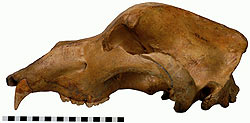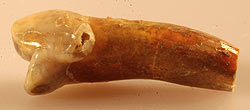 By LEE BOWMAN Scripps Howard News Service June 03, 2005
The technique developed by researchers at a U.S. Department of Energy laboratory in California and described in a report published online Friday by the journal Science, holds promise for new analysis of another species that disappeared about the same time - Neanderthals.
What has thwarted many earlier attempts to sequence genomes of extinct species has been the contamination left behind in ancient bones and teeth as microbes have entered the remains during the process of decomposition. DNA from those organisms, along with occasional bits of genetic material shed by fossil hunters or lab workers, result in too much clutter. The scientists at the Joint Genome Institute in Walnut Creek, Calif., used what they term a "metagenomic" approach that allowed them to sift through huge amounts of DNA in two samples of 40,000-year-old cave bear remains taken from caves in Austria. "With this strategy, we weren't terribly concerned that much of what we were sequencing were microbial contaminants but hoped that among the large amounts of sequences that we were generating would be some of the ancient DNA that we really were interested in. We were looking for the proverbial needle in the haystack," said Eddy Rubin, director of the institute.
"It worked. Among the expected lion's share of contaminants we recovered reasonable amounts of 40,000-year-old cave bear DNA and useful information from it. We were lucky in that we had a very powerful magnet in the form of industrial strength computing to tease out the interesting data from a hodgepodge of different DNAs." In fact, about 6 percent of the genetic strings in the samples yielded cave bear DNA sequence. But within that fraction, there was a range of sequence types, including fragments of 21 genes, that could be identified by comparing the cave bear samples to sequences from the next closest living relative that's been fully mapped - the dog. Canines and bears, which diverged on the evolutionary family tree about 50 million years ago, are about 92 percent similar in genetic sequences. Cave bears and today's brown bears and polar bears split from a common ancestor about 2 million years ago, but the cave dwellers didn't make it out of the last Ice Age in Europe. Paleontologists speculate that a combination of pressure from brown bears, climate change and exhaustive hunting by modern humans who wanted to live in the same caves wiped out the animals.
Although the bears teeth indicate they were herbivores, they stood more than 5 feet tall and the largest weighed in well over 1,000 pounds, and sported huge paws and claws like those of a grizzly bear - formidable enough foes for humans armed with stone-tipped spears. There is fossil and cave painting evidence that bears played some special symbolic role in the lives of the Neanderthals, and European caves filled with the remains of tens of thousands of the giant bears may have given rise to legends of dragons in the mountains that persisted among modern humans well into recorded history. Rubin said the team specifically chose the cave bear samples they did because they are roughly the same age as many Neanderthal remains found in Europe. "Our real interest is in hominids, which include humans and the extinct Neanderthals - the only other hominid species we have to compare with humans. Our nearest living relative is the chimp, and that's 5 million years of divergence. Neanderthals, in particular, represent probably our closest prehistoric relative." If useful material from Neanderthal and perhaps other ancient humans could be extracted, sequenced and compared to gene maps for modern humans and chimps, it could help unravel many questions about our evolution and makeup, the researchers said. Rubin cautions that no one's talking about cloning anyone, and he particularly doubts that any viable DNA could be recovered from dinosaur fossils that are 70 to 200 million years old. He thinks the age limit for any sample to yield viable DNA is about 100,000 years.
On the Net:
Distributed by Scripps Howard News Service, http://www.shns.com Publish A Letter on SitNews Read Letters/Opinions Submit A Letter to the Editor
|
|||||


